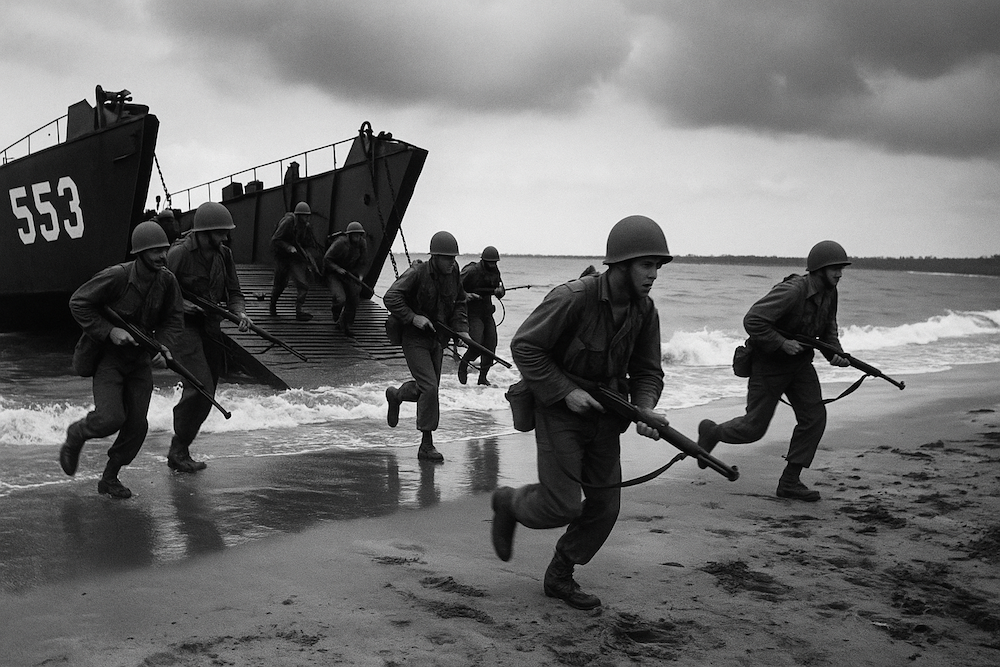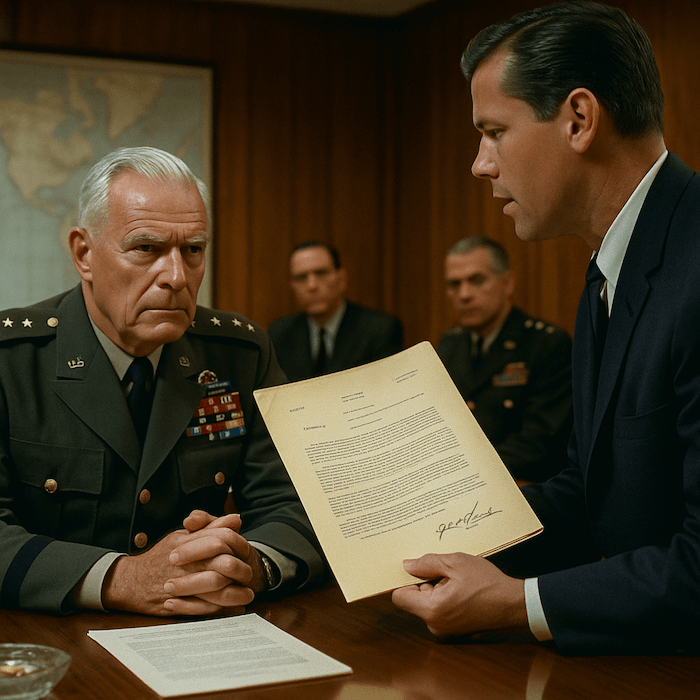In the spring of 1962, the highest-ranking military leaders in the US signed a document that is one of the most disturbing in US history. The plan included bombing American cities, sinking boats full of Cuban refugees, hijacking civilian planes, and carrying out terrorist attacks. People who did this would be agents of the U.S. government. Fidel Castro would be to blame. The reason would be war.

Operation Northwoods was a proposed false flag operation that stayed hidden in classified files for almost 40 years. When the papers finally came out, they showed how close America came to waging a secret war of terrorism against its own people.
The Bay of Pigs Disaster
We need to go back to April 1961 to understand Operation Northwoods. The Bay of Pigs invasion was meant to bring down Castro's communist government. Instead, it turned into what CIA analysts called "the perfect failure."
Around 1,400 Cuban exiles who had been trained by the CIA arrived at the Bay of Pigs on April 17, 1961. The operation fell apart in less than two days. Weeks before the invasion, Castro's intelligence had found out about it. On April 7, the New York Times published information. The Cuban army, which had about 20,000 troops, beat the exile brigade. Over 1,100 were taken prisoner.
Kennedy got this plan from Eisenhower, but he had big doubts about it. His biggest worry was keeping plausible deniability so the Soviets wouldn't strike back. When B-26 bombers painted to look like Cuban planes attacked on April 15, no one fell for the trick. Kennedy called off a second air strike, which sealed the invasion's fate.
The disaster made Castro's position stronger, pushed Cuba further into the Soviet sphere, and hurt America's reputation around the world. The young president thought the military and intelligence community had let him down.
Operation Mongoose
There had to be a response to the Bay of Pigs humiliation. Kennedy gave the go-ahead for Operation Mongoose in November 1961. This was a secret plan to get rid of Castro through ongoing sabotage, psychological warfare, and destabilization.
Kennedy put his brother, Robert Kennedy, in charge as Attorney General. Robert Kennedy said at a meeting on January 19, 1962, that getting rid of Castro was "the top priority of the U.S. government. All else is secondary. No time, money, effort, or manpower is to be spared."
Edward Lansdale, a famous CIA agent who worked in the Philippines and Vietnam, was in charge of the operations. On February 20, 1962, he laid out a bold six-phase plan that would end with an open revolt against Castro in October 1962.
But as the weeks went by, the frustration grew. Even with a lot of resources, the results were still poor. It was hard to gather intelligence. Sabotage operations stopped. Castro's hold stayed strong. The Joint Chiefs of Staff started making their own plans in this desperate situation.
General Lemnitzer and the Fight of Worldviews
In 1962, General Lyman Louis Lemnitzer was in charge of the Joint Chiefs of Staff, which was the most powerful military position in the United States. Lemnitzer was the old guard. He graduated from West Point, fought for Eisenhower in World War II, and led troops in Korea.
Lemnitzer thought that Kennedy's refusal to give air support during the Bay of Pigs was "absolutely reprehensible, almost criminal." The young president was being too nice to communism. Kennedy, on the other hand, no longer trusted the top military leaders. After the Bay of Pigs, he told historian Arthur Schlesinger that he wouldn't be "overawed by professional military advice." Schlesinger wrote that Kennedy thought Lemnitzer was "a dope."
Edward Lansdale asked the Joint Chiefs in early March 1962 for "pretexts that would justify U.S. military intervention in Cuba." What Lemnitzer came up with would become one of the most talked-about documents in American history.
The Northwoods Plan
On March 13, 1962, Lemnitzer gave Secretary of Defense Robert McNamara a top-secret memo called "Justification for U.S. Military Intervention in Cuba." It was part of Operation Northwoods, a plan for false flag terrorist attacks to be blamed on Castro. It had been signed by all the Joint Chiefs of Staff.

The document suggested a "Communist Cuban terror campaign in Miami, other Florida cities, and even Washington." Bombs would go off in carefully chosen places. Arrest Cuban agents. Documents would prove that Cuba was involved. The memo coldly said that this would "help project the idea of an irresponsible government."
The specific ideas were shocking:
"Sinking boats of Cuban refugees on the high seas," whether real or fake. Survivors would be rescued and taken to safety, making people feel sorry for Castro's victims.
A "Remember the Maine" event. The memo said clearly, "We could blow up a U.S. ship in Guantanamo Bay and blame Cuba." The writers said that "lists of casualties in U.S. newspapers would cause a helpful wave of national anger."
Using friendly Cubans dressed as hostile forces to stage attacks on Guantanamo Base. This could mean blowing up ammo dumps, which would kill American soldiers.
Taking over commercial planes. The most complicated plan was to get on a chartered plane with fake names for the passengers. The plane would be replaced with an identical one that could be controlled from a distance or made to look like it had been shot down. The real plane would land at an Air Force base, but the world would think Castro had killed innocent Americans.
Setting up terrorist attacks in the US, like bombings in Washington and Miami and attacks on Cuban refugees.
The paper even talked about getting or making Soviet planes in the US for use in deception operations. One memo said that these could be "used in a provocation operation in which Soviet aircraft would appear to attack U.S. or friendly installations in order to provide an excuse for U.S. intervention."
Kennedy Says No
Three days after Lemnitzer sent the memo, there was a meeting in the Oval Office on March 16 to talk about the rules for Operation Mongoose. Lemnitzer brought up military pretexts and told Kennedy that the military had "plans for creating plausible pretexts to use force."
Kennedy's answer was quick and to the point. Edward Lansdale wrote that "the President said bluntly that we were not talking about the use of military force." He also said that Lemnitzer might not be able to use his four divisions because they might be needed in Berlin if the Soviets reacted to American actions in the Caribbean.
The president had said no to Operation Northwoods. Kennedy fired Lemnitzer as Chairman of the Joint Chiefs of Staff just a few months later. Lemnitzer was sent to Europe as NATO's Supreme Allied Commander in November 1962, which was a big step down. Kennedy had basically kicked out the general who wanted to attack Americans.
But even after Lemnitzer left, people still wanted to take aggressive action. The Joint Chiefs kept planning false flag operations until 1963, according to documents that have been made public. Kennedy's decision to negotiate instead of following the military's advice to launch immediate strikes during the Cuban Missile Crisis in October 1962 made the divide even worse. More and more, military leaders thought Kennedy was not willing to take a strong stand against communism.
Four Decades of No Sound
For almost forty years, Operation Northwoods was kept secret in classified files. The American people had no idea that their top military leaders had suggested terrorist attacks on their own people.
In 1997, the John F. Kennedy Assassination Records Review Board made 1,521 pages of military records from 1962 to 1964 public. One of them was the Northwoods memorandum, which was made public on November 18, 1997.
But the American people didn't hear about it until 2001, when investigative journalist James Bamford published "Body of Secrets: Anatomy of the Ultra-Secret National Security Agency." Bamford called Operation Northwoods "a secret and bloody war of terrorism against their own country to trick the American public into supporting an ill-conceived war."
Bamford's story was heartbreaking. He called Lemnitzer "a dangerous, maybe even unbalanced right-wing extremist." But he stressed that the blame went beyond one person: "Operation Northwoods had the support of every single member of the Joint Chiefs of Staff."
Only ABC News wrote about Bamford's claims, with an article on May 1, 2001, called "U.S. Military Wanted to Provoke War With Cuba." People didn't seem to care. Maybe the story sounded too crazy. Maybe Americans couldn't picture their own military planning attacks on their own land.
On September 11, 2001, five months later, terrorists hit the World Trade Center and the Pentagon. The way people talked about Operation Northwoods changed a lot.
What We Learned and What We Left Behind
Operation Northwoods is now a case study in how the military and civilians get along and how far the government can go. The declassified papers show beyond a doubt that high-ranking American military officials suggested carrying out terrorist attacks on their own people to create a reason for war.
For historians, Northwoods shows how Kennedy and his military advisers had very different ideas about how to deal with Cuba and the Cold War. It shows how military planners might think about extreme measures when institutions are unhappy with civilian leadership.
The papers also show how tense things were in 1962. American leaders were feeling hopeless after the Bay of Pigs failure, Operation Mongoose not working out very well, and Castro being firmly aligned with the Soviets. In this situation, ideas that would have seemed crazy in peacetime started to come up.
Some scholars contend that Northwoods should be contextualized within the paradigm of Cold War clandestine operations, during which both superpowers consistently contravened international law. The CIA's plans to kill Castro showed that deadly secret operations had become standard practice.
Some people think that Operation Northwoods shows that the military is willing to undermine democracy when civilians don't agree with policies that the generals support. The willingness to kill American citizens to achieve a foreign policy goal shows a deep disrespect for both human life and democratic accountability.
The papers have also made people believe in conspiracy theories about what happened next. Some people say that Northwoods proposals are similar to real terrorist attacks, which means that false flag operations happened even though Kennedy said no. These theories usually don't have any proof and mix up the idea of a plan with its execution.
Everyone agrees that Operation Northwoods was suggested, approved by the Joint Chiefs, and turned down by civilian leaders. The civilian control system worked as it was supposed to. Kennedy said no, so the plan died.
What Northwoods Shows
The Operation Northwoods papers teach us a harsh lesson about how democracy works. We give military organizations a lot of power in democracies. The system relies on those institutions to accept civilian control and follow democratic rules.
Operation Northwoods shows what happens when military leaders think that civilians are making choices that could put them in danger. The Joint Chiefs didn't want to trust the president's judgment, so they tried to create a crisis that would force him to act. They were willing to kill Americans to make the political climate right for war.
This episode shows how important it is to have strong civilian leaders who are willing to stand up to military pressure. Kennedy got a lot of flak for how he handled Cuba. Military leaders doubted his determination. People on the right said he was too easy on communism. People in his administration who were hawks pushed for violence. But Kennedy stood firm.
It's worth thinking about what could have happened if a different president had been in charge. Someone who was more open to military advice might have said yes to the plan. Someone who was less secure in their political position might have seen it as a sign of strength. Operation Northwoods stayed on paper and never happened because one person made a choice at a certain time.
The story shows how important it is to be open and let people see what you have. For almost forty years, Americans didn't know that Operation Northwoods had been suggested. They weren't able to judge what their military leaders were willing to do or hold them responsible. People could only learn from this history and understand it when the documents were made public.
Conclusion
Operation Northwoods is one of the most disturbing things that has ever happened in the US military. It shows how far high-ranking defense officials were willing to go, even planning terrorism against their own people.
The story is also about how strong democratic institutions are. Kennedy was very clear when he turned down these suggestions. The plan was never put into action. No boats were sunk, no planes were hijacked, and no cities were bombed. It worked.
But we shouldn't feel too good about it. The system worked because Kennedy said no and civilian control was strong at a key moment. The proposals themselves show that the military establishment has lost sight of basic democratic values and sees American citizens as possible pawns in a game of geopolitics.
The lesson from Operation Northwoods is not that these things could never happen. The lesson is that they almost happened, and only strong civilian leadership stopped them. We need to be careful about military power in democracies. We need to demand that things be clear and that people be held accountable. We must remember that the people who are supposed to protect our safety may see democracy as a problem in some situations.
The National Archives has the papers, which were signed by the highest-ranking military officers in the United States in 1962. Those signatures prove that something happened in the past that should never be forgotten: in the spring of 1962, America's military leaders suggested going to war with Cuba by going to war with their own people. The president said no. But the fact that the question was even asked should still bother us.
References
- National Security Archive at George Washington University has released documents about Operation Northwoods.
- James Bamford, "Body of Secrets: Anatomy of the Ultra-Secret National Security Agency" (2001)
- Records from the Bay of Pigs and Operation Mongoose at the John F. Kennedy Presidential Library
- U.S. The Department of State's Office of the Historian has documents about foreign relations.
- David Ruppe of ABC News: "U.S. Military Wanted to Start a War with Cuba" (2001)
- The Black Vault has documents about Operation Northwoods
- CIA Reading Room - JFK Assassination Records Review Board documents
- National Archives - JCS Central Files 1962, Document 202-10002-10104
